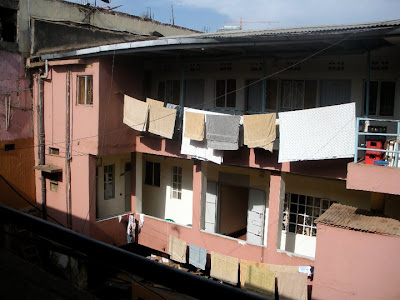I finished up my practicum with UNICEF on Friday, and moved out of the Muzungu house the next day. Those two "lasts" like all things towards the end, were bittersweet. But I don't want to talk about "emotions" now. I'll leave that for my next/last post.
Instead, I just want to tell you all a little big about what I did during those six weeks. In the end, my practicum went super well. Once I was able to really start working (around week 3... oh well) I was able to accomplish a lot. Ultimately, I did a feasibility study for a larger, country-wide resource using Gulu District as a prototype. This involved learning about how UNICEF collects and stores aid information, how to connect diffused sources of information to create a complete picture of UNICEF aid, and consulting with those far tech savvier than I (which is really everyone) on how to best display this data in a web-based resource.
In the end, I discovered that a lot is possible. For many projects, individual cash requisitions can be tracked as far as to the location (aka clinic or school) level. However, this level of specificity required a lot of effort on my part pouring through the paper records I mentioned in my previous post to get the most specific possible information. Fortunately, a lot can be automated. I discovered that it would be possible, through digital databases, to completely automate tracking UNICEF funding down to the district level, which would represent a huge improvement over the national-level information that is currently the standard.
However, that isn't really good enough. It isn't sufficiently meaningful to a citizen on the ground to know that their district is expected to receive a certain amount of funding, and it weakens the ability of aid organizations to coordinate activities to avoid duplication or cross-contamination if they only can tie activities to the district level.
I am fortunate that the staff at UNICEF recognize this as well. They recognize the value of transparency, and want to position themselves as leaders in that field in Uganda. That was what I really took away from my practicum. It was encouraging to see that UNICEF Uganda was very serious about moving forward with this project and improving the way in which they give aid, and more encouraging/bizarre, that I could sit in the same room with the Head of the Uganda country office, and he was willing to listen to my advice. Strange, but awesome. I am very excited to witness my work reach it's full potential in someone else's hands next year (they will be hiring someone to finish this project). As I said in the presentation I gave today, maybe this won't change anything, who knows, but I think it represents a small step in the right direction, which is very encouraging.
For now, I want to share the mock-ups I designed with one of the aforementioned tech-savvy UNICEF employees so you can get a little taste of what this web-site will become.

The sub-counties of Gulu District are shaded based on amount of aid received. The icons represent UNICEF project locations.
 The size of the circles around a location represent the amount of funding going to that location. You can see that some locations receive a lot of funding while others receive none.
The size of the circles around a location represent the amount of funding going to that location. You can see that some locations receive a lot of funding while others receive none. Shows where within Uganda a certain donor (e.g the world bank) is active.
Shows where within Uganda a certain donor (e.g the world bank) is active. This view shows all active projects at a certain location, making duplication or gaps in aid apparent.
This view shows all active projects at a certain location, making duplication or gaps in aid apparent. 









